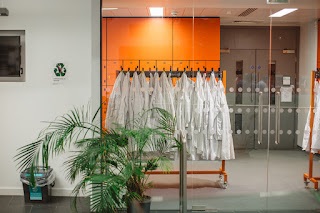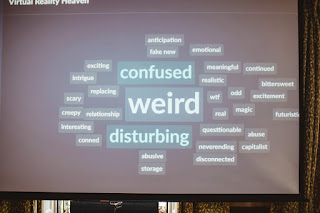Step 8: One Size Does Not Fit All
Part of the big idea with Kilter's year-long knowledge transfer secondment at Bristol University was to create a framework for other similar collaborations in the future.
This blog is one of the ways in which we are trying to share our learning so that other artists & academics can learn from our mistakes & embrace some of the opportunities we've identified.
As you will see from the shape of the blog, at the outset we hoped to create a 10 part process: 10 simple steps for the artist to go from zero to hero in a hitherto unpronounceable research discipline... and, for the researcher on the other foot, to go from die-hard 'knowledge-is-for-knowledge-
A few short weeks into the collaboration, it became clear that one size does not fit all & we were going to have to call on our bespoke tailoring skills to create a pair of carefully crafted, individual, figure-hugging outfits that would only look good on one particular research centre apiece.
The two partners - Quantum & Virtual Reality- are so different that to create an exact replica of the process twice over would be a wasted opportunity. Two wasted opportunities. We would miss chances to benefit from intricacies & specialisms & in all likelihood we would teach grandma to suck eggs left, right & centre.
Here is our spot-the-difference guide to show where we ended up departing from a rigorous template:
1. The quantum and VR teams worked in quite different research environments. The quantum team were deeply entrenched in development and experimentation, their environment personified a highly sophisticated laboratory. Meanwhile the VR team were situated within the Centre for Innovation and Entrepreneurship - a relatively new addition to the university - which is set up to foster interdisciplinary teaching and research. Their environment is much more flexible and ever changing
2. In quantum, we were engaged with an entire research centre numbering nearly 100 researchers. With the VR team, we were engaging with a much smaller team of researchers who were engaged in a very specific aspect of the technology as part of a much larger ongoing research project involving several universities and academic disciplines
It is much easier to get 4 people in the room than 100. We managed to have regular meetings with the same people in VR month after month. With Quantum we were still meeting new people, creeping out the woodwork, in our final weeks.
Neither of these is wrong. Regular meetings means steady progress & a good shared vision. A more scatter-gun approach leads to useful chance encounters, left-field ideas & new energy entering the fray when you need it most.
3. Our VR collaborators are focusing on future ethics & that's the focus of the secondment. Meanwhile in quantum, some of our collaborators don't even think ethics exist in their field. Both of these standpoints are equally exciting from Kilter's point of view but they cannot both be subjected to the same process. We learned a lot about the minutiae of academic ethics-approval in VR; we asked a lot of fundamental questions about the nature of humanity in quantum.
4. The quantum research centre has a hierarchy, ranging from early-career Phd students all the way up to world-leading pioneers. The VR research group has just 2 rungs of established, embedded researchers. Some of our quantum colleagues started work at the Nanoscience & Quantum Institute after we did. Consequently, there was a greater need for in-house training & repeating ourselves & opening up new boxes of ideas all the time.
5. The two sets of researchers ran to a different time-table in different parts of the city. On the few occasions where we call came together, there was a clear sense of how useful it was to compare & contrast processes & practices... but realistically it could only happen a handful of times. We got to look at each others bespoke tailoring but not to try it on.
--
There we have it. Some of the building blocks remain the same. You could write a rule-book with some elementary stages that applied across the board but above & beyond anything else at the top of the first page it would be worth writing in thick pen: ONE SIZE DOES NOT FIT ALL.


Comments
Post a Comment